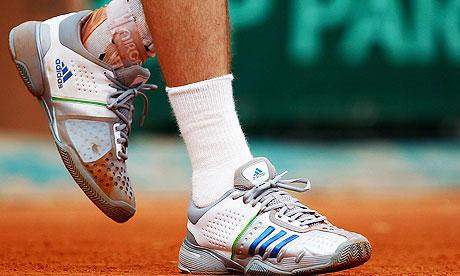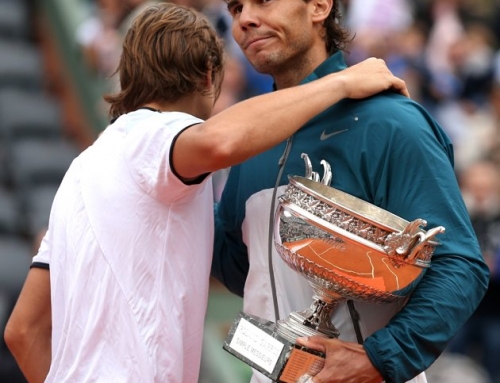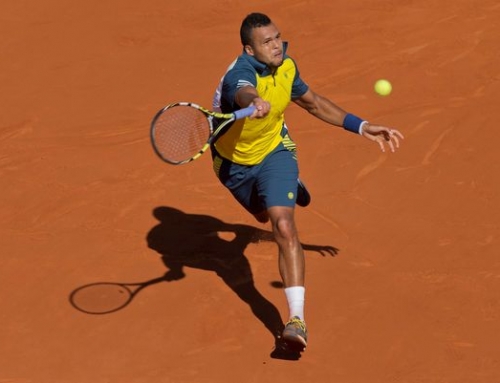 It was thought that the powerful Soderling would have a chance against Nadal. Nadal had yet to play anyone that hit as hard as Soderling. Nadal would have to up his game to face the one man that had beaten him on clay. But Nadal had done it twice before in Slams, once last year in Paris, and once again at Wimbledon.
It was thought that the powerful Soderling would have a chance against Nadal. Nadal had yet to play anyone that hit as hard as Soderling. Nadal would have to up his game to face the one man that had beaten him on clay. But Nadal had done it twice before in Slams, once last year in Paris, and once again at Wimbledon.
Still, Nadal didn’t feel that sharp. He was taken to five sets by Isner. He was pushed by Andujar. He looked only OK against Ljubicic. Even so, Nadal knows how to win. He knows how to get better as the tournament moves along.
Nadal expected a tough challenge. What he didn’t expect was an error prone Soderling. Soderling was hitting hard as usual, but he was missing, with 40 unforced errors, nearly triple of Nadal. Nadal was serving over 70% while Soderling served less than 60%. Soderling kept it pretty close in the third set forcing a tiebreak, but Nadal won comfortably. Nadal may have looked shaky, but he has a title to defend.
At the start of the tournament, everyone felt Murray had a decent shot at the semifinals. In his section, the seeds were Milos Raonic, who has cooled down considerably since his rather hot start to the year where he reached the fourth round of the Australian Open and then won a tournament in San Jose. But Raonic lost in the first round, so Murray didn’t have to play him.
He only had to face one of Alexandr Dolgopolov and Viktor Troicki, but he had never lost to Troicki and had beaten Dolgopolov at the quarters of the Australian Open. And, if he had gotten past that, the seeds in the quarterfinals would be one of Melzer, Anderson, Mayer, and Almagro, three of whom are tough clay courters. But none of these seeds made it that far.
Murray became his own worst enemy when he twisted his ankle against Berrer. He should have been out of the tournament then, but Berrer was so charitable in his playing, that he didn’t really try to play to Murray’s injury. Murray then looked to be in trouble against Troicki down 5-0 in the first set but somehow managed to get 4 games back. Although he lost the second set, he came back to win sets 3 and 4.
The match was then called because of darkness. Murray went down 5-2, held serve to 5-3, then was down 30-0 when he played two good points, then a third, and eventually secured a break against a nervous Troicki. He would hold serve, then break a second time, then hold to get 5 games in a row and take a match that should have been Troicki.
Murray should have been the favorite against Chela, a veteran of the tour ranked in the mid 30s who had nonethless never reached the semis of a Slam. Yet, it was Chela taking the lead with Murray down 1-4, 15-40, but managed to come back and hold that game. At 4-5, with Chela serving for the set, Murray managed another break.
Murray seemed content in this match to play long rallies. He wasn’t going for huge shots like he did against Berrer. It seems Murray prefers to have a set where he gets warmed up, and after this happens, he starts going for bigger shots. However, early on, Murray did expose one strategy that he could come back to again and again: the drop shot. Chela is not known to be the fastest player. He had also played two five-setters, so it seemed like Murray wanted to take the legs from Chela and have him run as much as possible, especially if the match were to go 5 sets.
Murray took the first set in a tiebreak and opened the second set with a double break lead. However, Murray couldn’t close it out right away with Chela coming back with two breaks of his own to tie the match 5-all. However, Murray breaks again and then holds for 7-5.
Murray opens the third set with a break and eventually gets a second and it seems, short of another collapse, Murray will win this in straight sets. Murray eventually hits a drop shot at match point (just as he did against Troicki) to win the match. Chela does not bother to chase it down.
So that leads Murray to his first ever semifinal against Rafael Nadal. Murray will try to heal some more, but he appears to be moving fine. His main concern is how slowly he has been starting matches and how each match, he’s had to dig to win. He hasn’t had a truly dominant performance except, oddly enough, his match against Berrer.
Murray seems to realize that his game gives most players that don’t have huge shots trouble. Against Troicki, Murray sliced and sliced and sliced. Few players would alter their game so drastically to play their opponents. That would almost be like Nadal serving and volleying. The closest example of a player who altered his game this much was Ivan Lendl learning to push his shots against Connors, and slicing a lot off his backhand.
Historically, Murray has lost to big hitters at the French. Last year, he lost to Berdych. The year before, he lost to Gonzalez. The year before it was Nicolas Almagro. This year, Almagro could have been that guy or maybe Melzer. But of the players he played, perhaps Troicki might have been that hard hitter. Still, Troicki is not Soderling or del Potro.
And now he faces Nadal. Murray has been employing a strategy against his last two opponents, Troicki and Chela, that he hasn’t used in some time. He used to dink and dunk in his early career but it left him open to players that would pound the ball. Nadal, of all players, is most immune to this kind of strategy. Hit a low shot, and he’ll go for a winner (or a near-winner, in Nadal’s case).
Murray’s strategy has generally been to attack Nadal. He could have done that against Chela but it almost seemed like Murray wanted to work on his consistency. Chela wasn’t going to go for huge shots, so Murray treated it like a practice session working on moving the ball around, playing lengthy rallies, but not being pressured that much. Murray got to work on drop shots and slice shots. But will any of that work on Nadal?
It’s not clear what Murray would do to disrupt Nadal while Nadal just needs to play his game to win. This is fairly interesting, I think.
The men get a day of rest tomorrow. It’s interesting how the Slams sometimes puts the top seed at a disadvantage having them play on the day closer to the semis. Djokovic gets even more rest than that. He asked McEnroe for a hit. He is still struggling with serve and volley.
Most people would say that Nadal would beat Murray. Even a healthy Murray would struggle against an average Nadal. Murray lost to Nadal in Madrid because his power game fell apart in the third set. Also, Nadal simply became more aggressive after playing a touch passive to lose the set. And, most would say Djokovic would beat Federer, though I think this match is closer.
Federer talks a good game, as usual. He plays his mind games, saying that Djokovic might be satisfied getting closer to number 1, that Fed doesn’t need another French, and that all he wants to do is give himself opportunities and take them where he can. He thinks the pressure is on Djokovic. Federer does this just subtly enough that his observations do make sense, but that they may get Djokovic to think some.
Who would have thought, at the end of 2010, that the match everyone wanted to see wasn’t Federer-Nadal but instead Djokovic-Nadal? Murray and Federer would like to have something to say about that, but it would take exceptional matches on both players to do that.




![[French Open] The tactics of the Djokovic-Nadal semifinals](https://www.essentialtennis.com/wp-content/uploads/2013/06/20130607nole-500x383.jpg)
![[French Open, SF] David Ferrer defeats Tsonga in straight sets to reach first Slam final](https://www.essentialtennis.com/wp-content/uploads/2013/06/20130607ferrer-500x383.jpg)
![[French Open, SF] Nadal escapes epic 5-setter with win over Djokovic, to compete for 8th title](https://www.essentialtennis.com/wp-content/uploads/2013/06/20130607rafa-500x383.jpg)
